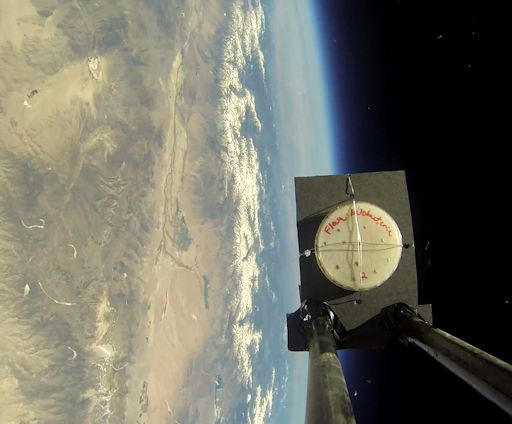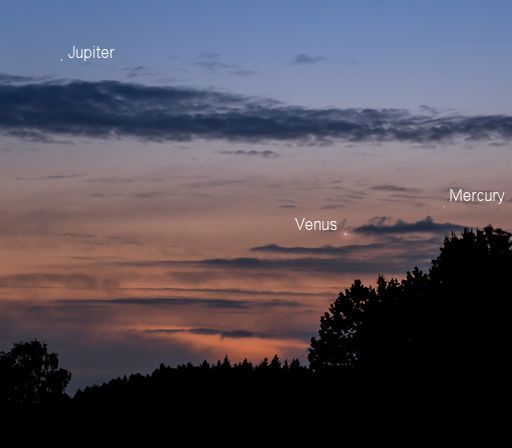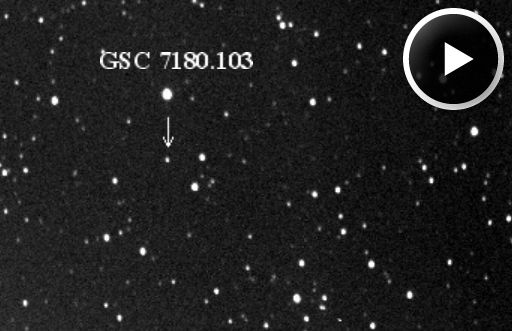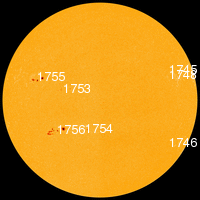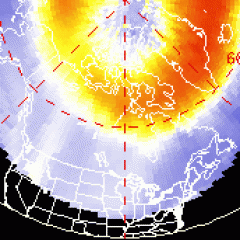CME STRIKE: As expected, a CME propelled into space by the M5-class explosion of May 22nd delivered a glancing blow to Earth's magnetic field on May 24th around 1800 UT. NOAA forecasters estimate a 55% chance of polar geomagnetic storms in response to the strike. High-latitude sky watchers should be alert for auroras shining through the bright moonlight. Aurora alerts: text, voice.
BACTERIA FLY INTO RADIATION STORM: Two days ago, high school students in Bishop, California, using a suborbital helium balloon launched a petri dish full of extreme-loving halobacteria into the strongest radiation storm of the year. They wanted to know how the extremophiles would fare when peppered with protons at the edge of space. Here is a picture of the sample 108,000 feet above Earth's surface:
The radiation storm was sparked by an M5-class solar flare on May 22nd. Students launched their microbes in the immediate aftermath of the flare when the highest energy protons (E > 100 MeV) were peaking in intensity. In addition to solar protons, the bacteria experienced air pressures only 1% that of sea level on the Earth below, temperatures as low as -65 C, and 70 mph winds. A student recovery team collected the payload from a remote desert in Nevada on May 23rd. Now they are culturing the bacteria to see if they survived.
The students, who call themselves Earth to Sky Calculus, have been launching research balloons for more than two years. Their projects include studies of high-altitude biology, measurements of the effects of solar flares on the ozone layer, and stratospheric photography of meteor showers.
How do they afford all this? To fund their activities, they have started a business called "Edge of Space Advertising." For a fee, they'll fly your banner, card, cow, running shoes, president or other object to the edge of space and send you the video. Contact Earth to Sky Calculus mentor Dr. Tony Phillips for details.
SUNSET PLANET SHOW: When the sun goes down tonight, step outside and look west. Venus, Jupiter and Mercury are converging to form a bright triangle in the sunset sky. The best evening to look is May 26th, when the planets will fit within a circle less than 3o wide. Petr Horálek photographed the convergence over the Czech republic on May 24th:
There won't be another triple conjunction of planets until October 2015, so don't miss this one! Science@NASA has the full story.
A BIG ASTEROID APPROACHES: Near-Earth asteroid 1998 QE2 is approaching the Earth-Moon system for a flyby on May 31st. There's no danger of a collision; at closest approach the asteroid will be 3.6 million miles away. Even at that distance, however, the 1.7-mile-wide space rock will be an easy target for mid-sized backyard telescopes. Using a 14-inch Celestron, Alberto Quijano Vodniza of Narino, Colombia took this picture of 1998 QE2 on May 17th:
The sunlit side of the asteroid will turn more squarely toward Earth during the first week of June. At that time it will reach a maximum brightness of 11th magnitude.
NASA radars will be monitoring the flyby, too. "Asteroid 1998 QE2 will be an outstanding radar imaging target at Goldstone and Arecibo and we expect to obtain a series of high-resolution images that could reveal a wealth of surface features," says radar astronomer Lance Benner of JPL. "Whenever an asteroid approaches this closely, it provides an important scientific opportunity to study it in detail to understand its size, shape, rotation, surface features, and what they can tell us about its origin."
Stay tuned for updates and observing tips.

![]()
Solar wind
speed: 555.8 km/sec
density: 8.0 protons/cm3
explanation | more data
Updated: Today at 1846 UT
![]()
X-ray Solar Flares
6-hr max: C2 1635 UT May24
24-hr: C2 0124 UT May24
explanation | more data
Updated: Today at: 1800 UT
![]()
![]()
![]()
Daily Sun: 24 May 13
![]()
![]()
Sunspots AR1755 and AR1756 have 'beta-gamma' magnetic fields that harbor energy for M-class solar flares. Credit: SDO/HMI
![]()
![]()
![]()
Sunspot number: 117
What is the sunspot number?
Updated 24 May 2013
Spotless Days
Current Stretch: 0 days
2013 total: 0 days (0%)
2012 total: 0 days (0%)
2011 total: 2 days (<1%)
2010 total: 51 days (14%)
2009 total: 260 days (71%)
Since 2004: 821 days
Typical Solar Min: 486 days
Update 24 May 2013
The Radio Sun
10.7 cm flux: 135 sfu
explanation | more data
Updated 24 May 2013
![]()
![]()
![]()
Current Auroral Oval:
![]()
Switch to: Europe, USA, New Zealand, Antarctica
Credit: NOAA/POES
![]()
![]()
![]()
Planetary K-index
Now: Kp= 2 quiet
24-hr max: Kp= 3 quiet
explanation | more data
![]()
Interplanetary Mag. Field
Btotal: 8.8 nT
Bz: 6.7 nT south
explanation | more data
Updated: Today at 1846 UT
![]()
![]()
![]()
Coronal Holes: 24 May 13
![]()
![]()
Solar wind flowing from this coronal hole could brush past Earth's magnetic field on May 27-28. Credit: SDO/AIA.

